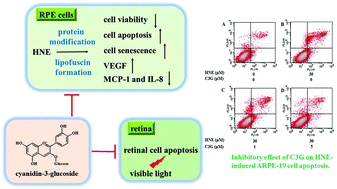Cyanidin-3-glucoside attenuates 4-hydroxynonenal- and visible light-induced retinal damage in vitro and in vivo
Abstract
4-Hydroxynonenal (HNE) is a highly reactive end-product of lipid peroxidation reaction that leads to retinal pigment epithelial (RPE) cell damage. Cyanidin-3-glucoside (C3G), the most abundant anthocyanin in the edible parts of plants, is a nutritional supplement used for preventing retinal damage. However, the protective effect of C3G against HNE-induced RPE cell damage remains to be elucidated. The protective mechanisms of C3G on ARPE-19 cells after HNE exposure were investigated in this study. Results showed that compared with HNE-treated cells, the viability of ARPE-19 cells was significantly (P < 0.05) increased after 1 and 5 μM C3G treatment. C3G exhibited a significant (P < 0.05) inhibitory effect on the expression of senescence-associated β-galactosidase in ARPE-19 cells. VEGF levels in the C3G groups were significantly (P < 0.05) decreased relative to those of the HNE-treated group. C3G also regulated the release of two inflammatory mediators, namely monocyte chemoattractant protein 1 and interleukine-8, in ARPE-19 cells after HNE treatment. Furthermore, C3G attenuated retinal cell apoptosis in pigmented rabbits induced by visible light. Therefore, our data showed that C3G has efficient protective effects on HNE-induced apoptosis, angiogenesis, and dysregulated cytokine production in ARPE-19 cells.



 Please wait while we load your content...
Please wait while we load your content...